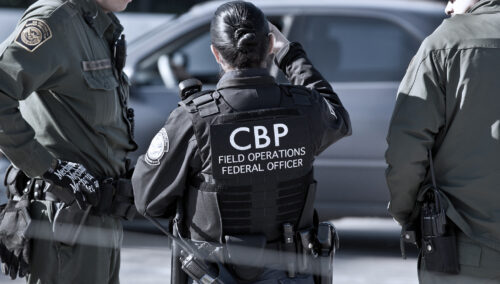This Fact Sheet focuses on changes made to immigration detainers under the Obama Administration resulting from the creation of the Priority Enforcement Program (PEP) in 2014, and related legal decisions. For an overview of immigration detainers, see “Immigration Detainers: An Overview.”
What changes were made to detainers under the Obama administration?
In November 2014, the federal government announced changes to its detainer policies by ending the Secure Communities Program and replacing it with the Priority Enforcement Program (PEP). Secure Communities and PEP are similar in that, under both, every person booked into a participating jail has his or her fingerprints checked against immigration databases. Using the results of the fingerprint check and taking into account established immigration enforcement policies, Immigration and Customs Enforcement (ICE) makes a determination about whether to take enforcement action against an individual.
At the same time that the federal government announced PEP, it also adopted new enforcement priorities. As announced in 2014, ICE has three priority levels:
- Level 1) noncitizens convicted of a felony, those engaged in terrorism or gang activity, or those apprehended at the border while attempting to enter unlawfully;
- Level 2) noncitizens convicted of three or more misdemeanor offenses, one “significant misdemeanor,” or those who recently entered the U.S. without authorization; and
- Level 3) noncitizens who have been issued a final order of removal.
If ICE determines that an individual in criminal custody falls into one of the immigration enforcement priorities, ICE can reach out to the law enforcement agency (LEA) holding that individual to request some level of collaboration. Under PEP’s predecessor program, “Secure Communities,” there was one immigration detainer form: an official request from ICE to another LEA—such as a state or local jail—that the LEA maintain custody of an individual for an additional 48 hours beyond the time he or she would otherwise be released from local custody so that ICE could arrange to assume custody of the individual.
With PEP, when a noncitizen who falls into one of the three buckets of priorities is identified, ICE can still issue a detainer. However, ICE replaced requests for detention with two different forms—the first which is similar to the original detainer request, and the second which requests only that the LEA notify ICE before it releases the person:
- Form I-247D, Immigration Detainer – Request for Voluntary Action, which requests that the LEA maintain custody of a suspected removable individual who meets certain enforcement priorities for a period not to exceed 48 hours after the time he or she would have otherwise been released.
- Form I-247N, Request for Voluntary Notification of Release of Suspected Priority Alien, which requests that the LEA notify ICE of the release from custody of a suspected removable individual who meets certain enforcement priorities at least 48 hours prior to release.
In addition, ICE added Form I-247X, Request for Voluntary Transfer, which may be issued when an individual does not fit within the enforcement priorities, but ICE still wants to take enforcement action. It may be issued against individuals who have not been convicted of a crime and are not security risks, but who recently crossed the border, have not resided in the U.S. continuously since January 1, 2014, or who significantly abused a visa program. The I-247X requests that the LEA maintain custody of the individual for a period of up to 48 hours beyond the time of release. Thus, LEAs that wish to cooperate with ICE above and beyond the limited enforcement priorities can honor the I-247X detainer and hold individuals for ICE.
As was already the case under Secure Communities, detainers under PEP are not mandatory, and an LEA accordingly has discretion to decide which detainers to honor and under what circumstances. A detainer cannot be used to detain a person beyond 48 hours. If ICE does not take custody within 48 hours, a detainer automatically lapses, and the state/local law enforcement agency is supposed to release the individual.
ICE also modified the detainer forms in several ways:
- The current detainer and notification forms more clearly state that they are requests from DHS and that LEAs are not required to comply.
- The 48-hour period for which ICE requests that the LEAs maintain custody of individuals subject to detainers no longer excludes weekends and holidays.
- The forms now require, not merely request, that a detainer be served on the subject of the detainer in order for it to be effective, though there appear to be no mechanisms to oversee or enforce this requirement. There is no similar service requirement for subjects of notification requests. This means that individuals under a notification request may have no way of knowing there is a notification request pending against them.
- Detainer forms now require enforcement officers to establish that probable cause of removability from the United States exists by checking off a box on the form. DHS states on the checklist that a probable cause determination is based on (1) a final order of removal against the subject; (2) the pendency of removal proceedings against the subject; (3) biometric confirmation reflecting that the subject is removable; (4) statements by the subject to an immigration official and/or “other reliable evidence” that the subject is removable.
- The detainer and notification forms also contain new, stronger language stating that detainers “should not impact decisions about the subject’s bail, rehabilitation, parole, release, diversion, custody classification, work, quarter assignments, or other matters.” This addition is in response to immigrants with detainers being denied these options, often resulting in harsher criminal penalties or lengthened criminal custody.
What led to these changes?
As Secure Communities was being implemented nationwide, hundreds of local jurisdictions passed policies limiting their cooperation with ICE and their responses to detainers. These policies reflected a variety of concerns, including that Secure Communities was interfering with LEA’s ability to protect their communities, and that ICE was not adhering to its priorities. In addition, individuals who were held in local jails under detainers sued the federal government, and several federal courts found that detainers are not mandatory and that key aspects of detainers are unconstitutional. As a result, many local jurisdictions became concerned about their liability if they were to honor federal detainers. The court decisions included the following:
- In Galarza v. Szalczyk, the plaintiff was a U.S. citizen who was held on a detainer over a weekend after he posted bail and should have been released from jail. The Third Circuit found that the county did not have to enforce the detainer because detainers are voluntary. Furthermore, the court found that the county could be found liable for unlawfully holding an individual.
- In Morales v. Chadbourne, another U.S. citizen was held on a detainer for more than 24 hours beyond the time she should have been released. The First Circuit held that detaining someone beyond their release date is considered an arrest under the Fourth Amendment, and therefore ICE must have probable cause to issue a detainer.
- In Miranda-Olivares v. Clackamas County, the noncitizen plaintiff was held on a detainer, was not permitted to post criminal bail, and was then transferred to ICE. The Federal District Court held that being held on a detainer violated the Fourth Amendment right against unlawful arrest and detention regardless of the immigration status of the detainee. Furthermore, a detainer does not provide sufficient probable cause of removability to allow the local jail to hold an individual for ICE. Finally, the court ruled that the county would have to compensate the plaintiff for damages for unlawfully holding her.
Is the legality of ICE’s detainer program still being challenged in court?
Yes. In October 2016, the Northern District of Illinois held in Jimenez Moreno v. Napolitano, a class action lawsuit, that ICE’s detainer program violated federal law because it exceeded the government’s warrantless arrest authority. Although the plaintiffs were issued detainers in 2011, prior to the 2015 changes to the detainer program, the court noted the 2014 changes and determined that the detainer program currently in place was unlawful. The decision nullified thousands of detainers issued out of the ICE Chicago Field Office.
Additional litigation challenging the legality and constitutionality of detainers is pending.
Are detainers being issued in accordance with the new enforcement priorities?
Not necessarily. An August 2016 report by Syracuse University’s Transactional Records Access Clearinghouse (TRAC) concluded that ICE field offices have “largely ignored” reforms of detainer policies. Although the new detainer program under PEP purportedly seeks to target only individuals who fall into one of the three priority levels and who have been convicted of an enumerated crime or otherwise pose a threat to national security, according to the TRAC report, during the first two months of FY 2016, half of the detainer and notification requests were issued to individuals who had no criminal record, while 25 percent were for Level 1 offenses (the most serious), six percent were for Level 2 offenses, and 18 percent were for Level 3 offenses. Additionally, TRAC found that ICE was rarely using the I-247 voluntary notification document. Four of every five I-247s issued by ICE during the first two months of FY2016 were traditional I-247D detainers requesting that the LEA hold the individual. TRAC reported that very few I-247X forms had been issued on individuals who fall into the lower priorities.
These issues call into question whether the reforms to the detainer program were designed to be meaningful and can be successfully implemented in the field. More information and research about the detainer program is needed to determine if ICE and LEAs are complying with the changes.



